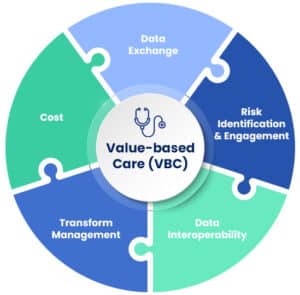Over recent decades, we’ve witnessed a pivotal shift in the global healthcare landscape. As chronic conditions have become more prevalent, nations worldwide have been reevaluating their healthcare delivery models, moving away from traditional fee-for-service models towards a more outcomes-focused approach. Both governments and private payers are now pondering a critical question: “How can we reimburse healthcare providers based on the positive outcomes for patients, rather than just for the services they provide?”
Value-Based Care
Value-Based Care (VBC) programs represent a transformative approach in the healthcare industry, aimed at improving patient outcomes, enhancing care quality, and reducing healthcare costs. Unlike traditional fee-for-service models, which reimburse healthcare providers based on the quantity of care services delivered, VBC focuses on rewarding providers for the quality and effectiveness of care they provide to their patients. This model aligns financial incentives with patient outcomes, encouraging healthcare providers to offer care that is both efficient and tailored to the individual needs of patients.

The impact of VBC on the healthcare ecosystem is multifaceted. Firstly, it prompts a shift in the focus of healthcare delivery from treatment to prevention and patient wellness. By incentivizing positive patient outcomes, VBC encourages providers to invest more in preventive care measures, chronic disease management, and holistic approaches to patient health. This can lead to a decrease in hospital readmissions, fewer unnecessary medical procedures, and overall, a more sustainable healthcare system.
Secondly, VBC fosters collaboration among healthcare providers. Since the model rewards the improvement of patient outcomes across the continuum of care, it encourages different providers to work together more closely. Hospitals, primary care physicians, specialists, and even non-medical support services are motivated to share information and coordinate care more effectively, ensuring that patients receive the right care at the right time.
Patient-Reported Outcomes (PROs) play a crucial role in the success of VBC programs. PROs are direct reports from patients about how they feel in relation to a health condition and its therapy, without interpretation of the patient’s response by a clinician or anyone else.
This information is invaluable because it provides insights into the patient’s perspective on their health status, quality of life, and the effectiveness of treatments.
In the context of VBC, PROs help to ensure that care delivery is genuinely patient-centered, enabling healthcare providers to tailor their interventions to meet the specific needs and preferences of each patient.
PROs contribute to the measurement and assessment of healthcare outcomes, which is central to VBC. By incorporating PROs into their assessment criteria, VBC programs can use this data to evaluate the effectiveness of care from the patient’s viewpoint. This ensures that healthcare interventions not only achieve clinical objectives but also improve the quality of life for patients. Consequently, PROs are essential for the continuous improvement of healthcare services, guiding providers towards interventions that offer the greatest benefit to patients’ health and well-being.
PROs in Clinical Trials
When life sciences companies present data from clinical trials that include PROs, they provide a more comprehensive picture of a product’s benefits. This evidence is particularly persuasive to payers and healthcare providers, who are increasingly looking for treatments that offer meaningful improvements in patients’ lives, not just clinical metrics. For payers, such information supports decision-making related to coverage and reimbursement, as it aligns with the shift towards outcomes-based reimbursement models. Products that demonstrate a positive impact on patients’ quality of life are more likely to be covered and recommended within these frameworks, ensuring broader access for patients.
Similarly, healthcare providers, who are integral to the VBC ecosystem, are more likely to prescribe products that have been shown to enhance patient outcomes and satisfaction. In the context of outcomes-based care, providers are rewarded for delivering high-quality, patient-centered care, which includes prescribing treatments that patients are more likely to adhere to because of their favorable impact on quality of life. Therefore, clinical trial data enriched with PROs can significantly influence prescribing behaviors by highlighting the patient-perceived benefits of a treatment.
 The inclusion of PROs in clinical trials signals to both payers and providers that a life sciences company is committed to understanding and addressing the holistic needs of patients. This can strengthen the company’s position in negotiations with payers and foster trust among healthcare providers, facilitating the successful adoption of new products.
The inclusion of PROs in clinical trials signals to both payers and providers that a life sciences company is committed to understanding and addressing the holistic needs of patients. This can strengthen the company’s position in negotiations with payers and foster trust among healthcare providers, facilitating the successful adoption of new products.
PROs bridge the gap between clinical efficacy and patient experience, enabling life sciences companies to better meet the demands of the evolving healthcare landscape where the patient’s voice is increasingly central to care decisions.
Leveraging PROs in clinical trials is not just about enhancing the evidence base for new medical products; it’s about aligning these products with the fundamental principles of VBC and ensuring they meet the real-world needs of patients, payers, and providers. In doing so, life sciences companies can enhance the marketability of their products, ensuring they are well-positioned for successful adoption, coverage, and use in a healthcare environment that values and rewards meaningful improvements in patient health and quality of life.
For more information, follow us on LinkedIn: Castor | Kristen Harnack
Learn more about Castor’s eCOA / ePRO
References:
- CMS (Centers for Medicare & Medicaid Services). “Value-Based Programs.” [CMS website]
- Health Affairs. “Value-Based Care and Population Health: Opportunities and Challenges.”
- HHS (Department of Health & Human Services). “About the Affordable Care Act.” [HHS website]
- FDA (Food and Drug Administration). “Patient-Reported Outcome Measures: Use in Medical Product Development to Support Labeling Claims.” [FDA website]
- Journal of Managed Care & Specialty Pharmacy. “Patient-Reported Outcomes in Performance Measurement.”


